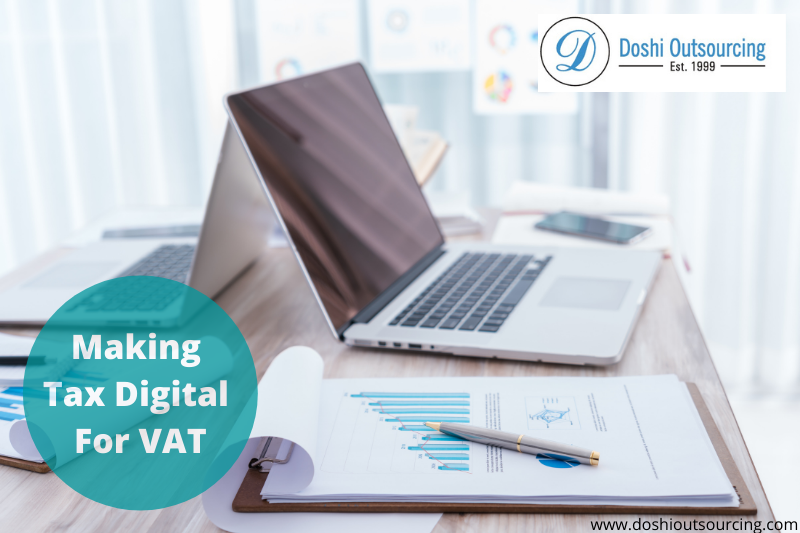Making Tax Digital: How Businesses can be ready for MTD in VAT?

September 04, 2020
What is Making Tax Digital (MTD)?
With effect from 1st April 2019, VAT registered businesses whose taxable turnover is above the VAT registration threshold (presently £ 85000 per annum) must keep their records in digital form and file their VAT Return using compatible software under MTD guidelines issued by HMRC. Businesses with a taxable turnover below the VAT threshold can also sign up or register for MTD for VAT voluntarily. MTD obligation doesn’t apply if businesses de-register from VAT or if they are exempt from MTD for VAT.
Steps to follow to be ready for MTD in VAT:
1. Know whether your business would be affected by MTD
As stated above, VAT registered businesses with taxable turnover above the VAT registration threshold (presently £ 85000 per annum) must keep their records in digital form and file their VAT Returns using compatible software under MTD guidelines issued by HMRC. Presently even if you haven’t crossed the threshold but approaching it, then it will be worthwhile to prepare for the same in advance. For this, you need to talk to your accountant.
Under MTD, businesses are also required to store some of their VAT information digitally. If they use more than one software to do that then they must be “digitally linked.” As a business, you might need to start preparing for these requirements well in advance. Also, the transition is easy for those businesses that are already using accounting software as they just need to update the features. Whereas for those who are using spreadsheets or other manual ways to prepare VAT returns, they need to switch to some latest compatible software for record-keeping and return filing.
Additionally, some businesses can claim exemption from MTD for VAT if individuals running those businesses have religious beliefs that are incompatible with the requirements, or their age, disability or remoteness doesn’t allow them to use digital tools. Insolvency procedures also affect MTD for VAT.
2. Figure out which Business processes need MTD adaptation
Businesses first need to ask the following questions:
a. How do you raise sales invoices?
b. How purchases and expenses are recorded?
c. Do you use accrual or cash system?
d. Are there any other areas in VAT record-keeping that are still paper-based?
MTD doesn’t mean you should not have any paper-based invoices, it just means that the most relevant and important invoices and all their data such as the ones stated above need to be entered into the MTD compatible software. You simply cannot just total all the invoices and enter the global figure as you used to do previously in your earlier software. It is here that it becomes highly imperative to talk to an experienced accountant so that they can guide you through these intricacies.
3. Use ‘Functional Compatible Software’
It is increasingly common for businesses to keep their records in electronic format in a computer, laptop, tablet or Smartphone. However, under MTD, the businesses must also use functional compatible software that would collate this digitally stored data, calculate the VAT return and submit/communicate this data to HMRC via the HMRC’s API (Application programming interface).
Some older software installed in your desktop may need updating or you may need to switch to altogether new accounting software (as some older software might never receive upgrades) that’s latest and compatible with MTD guidelines.
If you’re using cloud-based software (where data is saved on an external server and you can access it in real-time on any device – computer, mobile phone, tablet) then it should update automatically for MTD, although it is wise to check with your software vendor for further details regarding ease of use and any changes that might take place during the update.
If you keep your VAT records using spreadsheets such as Microsoft Excel then you have to use MTD-compatible bridging software to file returns as mandated by HMRC.
List of software suppliers who are developing MTD-compatible software is available on the HMRC website. Businesses have to acquire ‘Functional compatible software’ from such software suppliers if they don’t already have one. It is interesting to note that HMRC is not providing any software for free under MTD despite the fact that MTD for VAT is legally mandated.
4. Work out when to switch to MTD
Once you’ve figured out which business processes need MTD adaptation and install functional compatible software, then it’s time to switch to MTD if you haven’t already done so (since the deadline was 01st April 2019 for most businesses). However, it is interesting to note that HMRC has advised that it will be lenient with penalties during an initial "soft landing period" if businesses have made sufficient efforts to comply with MTD for VAT. In response to the Corona pandemic, all businesses now have until their first VAT period starting on or after 1 April 2021 to put digital links in place. This permits businesses more time to place digital links between all parts of their functional compatible software in place.
Also, at least initially, it would be wise for businesses to seek help from their accountants who have experience and software know-how. Accountants can do the handholding and train you for the new functionalities in the software as per the MTD guidelines.



